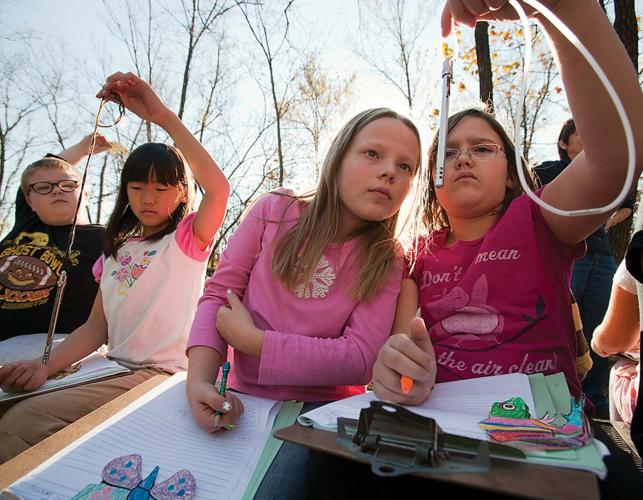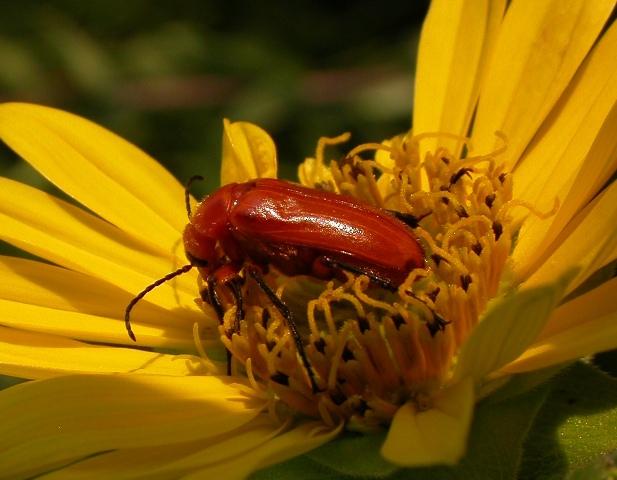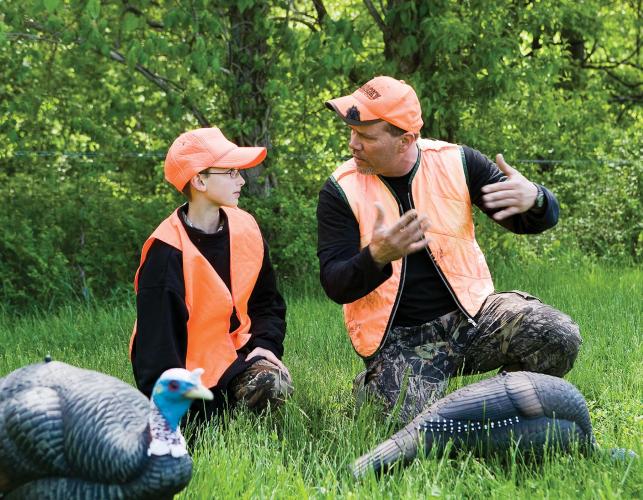Many of us can still remember the teacher, friend or family member who first inspired our love for the outdoors. It often takes root in our hearts and our minds. Over time, it becomes a part of who we are and guides our actions.
Today, we enjoy a conservation legacy nurtured by many generations before us, who shared their love of the outdoors and made it a part of our heritage. The Department continues to work with Missourians, and for Missourians, to conserve the fish, forest and wildlife of the state, as well as preserve our outdoor heritage and quality of life.
Central to the Department’s mission is making sure every Missourian has opportunities to learn about and enjoy nature. “We promote Missouri’s passion for conservation through hands-on activities and education with people throughout the state,” says MDC Outreach and Education Division Chief Mike Huffman.
“The Department helps educate and empower citizens in many ways: by offering outdoor programs to people of all ages at nature centers, by working with schools to teach top-notch curriculum that engages students in the outdoors, by sponsoring archery in schools, by coordinating the state’s successful hunter education program, and by providing shooting ranges and conservation areas to enjoy,” Huffman says.
“The Department also teaches outdoor skills and supports community conservation efforts in every county through agent outreach. A wide variety of publications, such as the Missouri Conservationist, our exciting new Xplor kids’ magazine, a number of go-to nature guides, as well as the MDC website, also help connect Missourians with nature,” says Huffman.
Nature Centers
Conservation education centers offer a huge range of programs touching on all aspects of the outdoors and conservation, from fishing workshops to presentations about wildlife and habitat. They are free and open year round. Each year, the Department’s nature centers connect almost a million people with the outdoors.
“At Burr Oak Woods Conservation Nature Center, we focus on helping people build the outdoor skills necessary to confidently explore the wild and beautiful habitats of Missouri with their friends and family,” says Lisa Lacombe, nature center manager.
Since Missourians passed the Design for Conservation tax in 1976, the Department has provided more outdoor education opportunities for Missourians, including seven nature centers located around the state. Those nature centers are:
- Anita B. Gorman Discovery Center, Kansas City
- Burr Oak Woods Conservation Nature Center, Blue Springs
- Cape Girardeau Conservation Nature Center, Cape Girardeau
- Powder Valley Conservation Nature Center, Kirkwood
- Runge Conservation Nature Center, Jefferson City
- Springfield Conservation Nature Center, Springfield
- Twin Pines Conservation Education Center, Winona
Other Department facilities that offer opportunities to learn about and enjoy Missouri’s diverse outdoors include August A. Busch Memorial Conservation Area near St. Charles, Kirksville Regional Office in Adair County, and Shepherd of the Hills Fish Hatchery Conservation Center Branson. Many other regional offices, conservation areas and hatcheries also offer exhibits. Find a nature center near you by visiting mdc.mo.gov/node/4439.
Discover Nature Schools
Children are the key to Missouri’s conservation future. By working closely with the Missouri Department of Elementary and Secondary Education, MDC has developed free, widely adopted curriculum materials for grades kindergarten through 12, called Discover Nature Schools (DNS).
“Discover Nature Schools is a science and conservation education program at its best,” says Kevin Lohraff, the Department’s education programs and curriculum supervisor. “DNS is packed with exciting and engaging hands-on activities designed to bring students in grades K–12 outdoors and closer to nature.”
“DNS builds on kids’ natural inquisitiveness, giving them opportunities to get outdoors and closely observe the world around them,” Lohraff says. “Students learn to ask questions, form hypotheses, come up with ways to find answers, collect data, and find out if their hypotheses are right—all while recording observations, sketches and reflections in their science notebooks. Kids learn science by becoming scientists, and they learn about nature while being in nature. This is the best way to learn—to learn by discovery.”
With DNS, students learn about Missouri plants, animals, their habitats, and how they all fit together. In becoming familiar with the outdoors just outside their classroom, students learn to value natural resources close to home.
DNS lessons are closely aligned with state education standards in science and biology. Activities involving recording, communicating and presenting new information integrate with math and language-arts class work. The program began in 2006. By 2012, more than 78,000 Missouri children were connected with nature through various DNS instructional units and grants.
There are four units for various school-age groups. Nature Unfolds was developed for kindergarten through second grade. Nature Unleashed—The Untamed World of Missouri Ponds, Forests and Prairies is for grades 3–5. Middle school students (grades 6–8) work with Conserving Missouri’s Aquatic Ecosystems. Nature Unbound—The Impact of Ecology on Missouri and the World was developed for high school students.
Funding for Conserving Missouri’s Aquatic Ecosystems comes in part from the Federal Aid in Sportfish Restoration Program, which distributes some fishing-related taxes towards sportfish conservation and education.
Along with free teacher training, student books and teacher guides for each unit, the Department provides grants for exploration equipment, outdoor classroom materials and field experiences. Conservation grants supporting Discover Nature Schools totaled $268,909 in 2011. Learn more at mdc.mo.gov/node/9019.
Archery In The Schools
The Missouri National Archery in the Schools Program (MoNASP) was created to teach kids the basics of archery as a part of school curriculum for grades 4–12. The program, part of the National Archery in the Schools Program (NASP), began in Missouri in 2007. Today more than 38,000 Missouri students from 227 schools participate in MoNASP. The 2012 state tournament drew more than 1,150 competitors from 55 schools.
Students of all sizes and abilities learn archery together, and at competitions, boys and girls are at the shooting line together. “You don’t have to be athletic, fast, big or strong to be good at archery,” says NASP’s co-founder, Roy Grimes.
When teacher Tracy Flood heard about the archery program, she knew it would be a good fit for her outdoor education class. Flood, a teacher at Crane Middle School, now has a waiting list of kids who want to take her class. “Archery is the most popular class in middle school. Once they’re hooked, they’re hooked. Kids want to shoot, so they make sure they keep their grades up.”
“Kids love archery, and archery helps kids excel,” says the Department’s MoNASP Coordinator Eric Edwards. “Statistics show that school archery programs improve school attendance, increase participants’ self-confidence and physical activity, they can better relate to what they are learning, it appeals to a great variety of students, it gets kids outdoors to discover nature, and for many, it can become an after-school activity.”
Communities are seeing the archery program as a great investment in their future. Local sporting clubs, conservation groups and civic organizations often donate archery equipment to schools, volunteer to help support after-school archery clubs and organize local competitions. In Missouri, the National Wild Turkey Federation, Whitetails Unlimited, Pheasants Forever, Quality Deer Management Association, Bass Pro Shops and the Friends of National Rifle Association are just a few of the groups that have donated equipment or funds to support schools.
“Success breeds success,” says Conservation Commissioner Don Johnson, who helped bring the archery program to Missouri. “Once kids succeed in archery, they find they can succeed in other parts of their lives.”
The Department certifies teachers with the required Basic Archery Instructor training at no cost to the teacher. In partnership with the Conservation Federation of Missouri, it also offers $500 grants to schools for equipment. Learn more at mdc.mo.gov/node/3813.
Hunter Education
Missouri’s Hunter Education Program offers many benefits to Missourians. “This safety program produces individuals who are responsible, knowledgeable, safe and involved in the outdoors,” says MDC State Hunter Education and Range Coordinator Tony Legg.
More than 1,600 volunteer and staff instructors provide training and certification through traditional classroom hunter education classes and through a combination online and field day course.
“The Missouri Hunter Education program is a prime example of government and volunteers working successfully together to save lives, promote conservation and keep the hunting heritage alive for generations to come,” says James Robertson, president of the Missouri Hunter Education Instructor’s Association, and volunteer instructor since 1991.
Missouri’s fist formal hunter safety training was created in 1957 as a voluntary course. The Department’s official statewide range program began in 1972 with the passage of the Dingell-Hart excise bill, amendment to the Pittman-Robertson Act of 1937, which provided funds for hunter education and target range development from excise taxes on handguns and archery equipment. Now known as the Federal Aid in Wildlife Restoration Program, this federal funding continues to support Missouri’s hunter education program.
In 1987, Missouri approved a mandatory hunter education requirement for all hunters during the firearms seasons beginning in 1988, for anyone born on or after January 1, 1967. This regulation marked the beginning of a new era in Missouri’s Hunter Education Program. To date, more than 1.1 million Missourians have completed the course. Due to the success of the program, Missouri’s model has become a standard-bearer, and has been widely adopted by many other states.
Mandatory hunter education has dramatically decreased and prevented many injuries and deaths. The number of hunting incidents began dropping dramatically in 1992, when any hunter under the age of 26 would have attended a hunter education course, and have declined steadily since.
The Department also offers free bowhunter education courses and a free, 15-minute online tree-stand safety course. Learn more at mdc.mo.gov/node/3095.
Shooting Ranges And Outdoor Skills
Your outdoor recreation can be safer and more satisfying if you increase your knowledge and hone your skills. The Department operates five staffed shooting ranges and outdoor education centers designed to improve outdoor skills and develop safer hunters.
These facilities are located in Platte, Jackson, Greene, Jefferson and St. Charles counties. They offer target shooting, as well as numerous outdoor skills programs, such as archery, map and compass reading, and wildlife identification. The Department also has more than 70 unstaffed ranges. Check for upcoming events at shooting ranges and outdoor education centers at mdc.mo.gov/node/6209.
Citizen-Led Conservation Education
Educating and involving future generations in the excitement of outdoor recreation and conservation opportunities involves the efforts of many partners. Any attempt to list them all could never be complete—but include Missourians who volunteer their time and expertise to a variety of Department programs (see sidebar on Page 14), The National FFA Organization, the 4-H Youth Development Program, Ducks Unlimited’s Green Wings, AmeriCorps volunteers, National Wild Turkey Federation, Conservation Federation of Missouri’s Conservation Leadership Corps, and a variety of important state and nationwide hunting and fishing organizations.
“Regardless of the organization, all of these individuals share a common bond, which is that they each donate an incredible amount of time and energy to share their love of the outdoors and to help preserve our outdoor heritage,” says Tim Ripperger, deputy director.
For the past 75 years, education has been a major focus of the Department. “Part of our mission is to provide the opportunity for all citizens to use, enjoy and learn about the forest, fish and wildlife resources of the state,” says MDC Director Robert L. Ziehmer. “It’s a partnership with Missourians, and for Missourians. It is gratifying to see so many Missourians sharing their love of the outdoors by teaching and mentoring tomorrow’s conservation leaders. The work we do today sows the seeds for a stronger connection to the land and the outdoors tomorrow.”
Agent Educators
Conservation agents provide law enforcement services to the public for protection and conservation of Missouri’s fish, forests and wildlife, as well as for safe and proper public uses of conservation areas. Conservation agents also provide conservation education in a broad range of settings:
- Prepare radio and television programs, newspaper articles, and meet with civic groups, schools, church groups and a wide variety of other organizations
- Help administer the Department’s Hunter Education Program, along with volunteer instructors and other MDC staff
- Provide habitat-planning information and food-plot seed to landowners
- Coordinate and support the Conservation Federation of Missouri’s Share the Harvest program, providing a way for hunters to donate deer meat to those in need
- Help stop poaching through the Operation Game Thief/Forest Arson hotline, which allows citizens to anonymously report poaching and forest arson
- Support programs such as Missouri’s National Archery in the Schools, Discover Nature Girls Camps, and take conservation on the road with both a cooking trailer to teach high school students the tastier side of hunting and fishing, and a trailer equipped to teach students about trapping
- Partner with organizations and businesses, in programs such as the Juniors Acquiring Knowledge, Ethics and Sportsmanship (JAKES) Program sponsored by the National Wild Turkey Federation; Ducks Unlimited groups and their Green Wings Program; and the Wonders of the Ozarks Learning Facility (WOLF), a partnership between the Springfield Public Schools and Bass Pro Shops.
Volunteers Vital For Success
The Department partners with tens-of-thousands of individuals to improve Missouri’s fish, forests and wildlife.
“Volunteers are the lifeblood of conservation in Missouri,” says Syd Hime, MDC volunteer and interpretive programs coordinator. “Thousands of volunteers provide tens of thousands of hours of volunteer service at our hatcheries, nature centers, offices and shooting ranges each year. Their passion and enthusiasm are contagious, and Missouri is a better place for it.”
Most volunteers contribute in one of these areas:
- Hunter education: Approximately 1,400 volunteers donated more than 34,000 hours last year as primary instructors for Missouri’s mandatory Hunter Education Certification and voluntary Bowhunter Education Certification courses.
- Staffed ranges: About 160 people donated more than 12,500 hours last year offering primary support for public firing line safety, shooting and hunting related programs.
- Nature centers: More than 450 volunteers at hatcheries and nature and interpretive centers throughout the state donated more than 12,300 hours last year. Volunteers develop and conduct programs, work with school groups, lead hikes, assist with area management and more.
- Master Naturalists: The Department also supports 1,200 Missouri Master Naturalists in 12 chapters, who provide more than 44,000 hours of volunteer service to habitat restoration and conservation efforts each year.
- Forest Keepers: More than 2,500 Forest Keepers volunteer almost 18,000 hours observing and reporting on the condition of rural and community forests.
- Stream Teams: More than 3,800 active Stream Teams improve and protect their adopted stream of choice. Teams perform dozens of activities like litter pickup, water quality monitoring, tree planting and storm drain stenciling. Last year, volunteers contributed more than 145,000 hours to our state’s stream resources.
The Department has many other volunteer opportunities to explore. If you’re interested in playing a role in keeping Missouri’s nature green, clean and healthy, learn more at mdc.mo.gov/node/4668.










Also In This Issue


And More...
This Issue's Staff
Managing Editor - Nichole LeClair Terrill
Art Director - Cliff White
Staff Writer - Bonnie Chasteen
Staff Writer - Jim Low
Photographer - Noppadol Paothong
Photographer - David Stonner
Designer - Stephanie Thurber
Artist - Mark Raithel
Circulation - Laura Scheuler






















